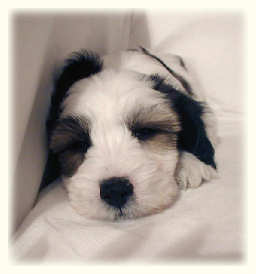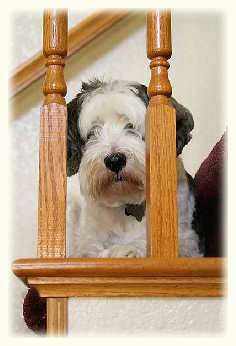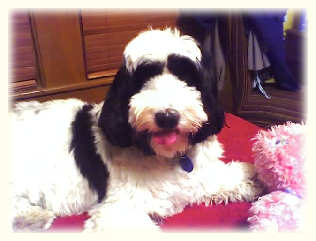|
The "Tibetan" Terrier Tibetan Terrier History - from the AKC Tibetan Terriers came from the land of Tibet where, they were bred and raised in the monasteries by the Lamas almost 2,000 years ago. Originating in the Lost Valley ("lost" when the access road was destroyed in the 14th century by a major earthquake) they were prized as companions and "Luck Bringers" or "Holy Dogs" for those fortunate enough to own them. The breed was called "terrier" because it was of a size widely associated with terriers. The occasional visitor to the Lost Valley who made the hazardous journey was often given a dog to safeguard him on the return trip to the outside world. In the 1920s a practicing physician was given a dog by a grateful Tibetan whose wife he had treated. When the physician returned to England, she established a famous kennel. The first "official" Tibetan Terrier arrived in the United States in 1956, an import from the above kennel and since then, the breed has attracted fanciers from Canada to Florida, and from coast to coast. Tibetan Terriers were valued in Tibet as companions, and were treated like children of the family. Like the children, they eagerly assisted in taking care of the family’s property, their flocks, and their herds, but they were not raised for utilitarian purposes. The breed was kept pure-bred, as any mismating might bring bad luck to the family and might even be blamed for any village misfortune. The Tibetan Terrier was admitted to registration in The American Kennel Club Stud Book on May 1, 1973, and to regular show classification in the Non-Sporting Group at AKC shows October 3, 1973. ************************************************************************************************ Tibetan Terrier - From Wikipedia The Tibetan Terrier is not a member of the terrier group, the name being given to it by European travelers to Tibet who were reminded of terriers from back home when they first encountered the breed. Its origins are uncertain: Some sources claim them to be lucky temple dogs, whereas others place them as farm dogs. The Tibetan Terrier is a dog with many uses, able to guard, herd, and also be a suitable companion dog. Their utility in Tibet meant that the first examples of the breed available in the west were generally given as gifts, as the Tibetan Terrier, along with other Tibetan breeds, were too valuable to the people who owned them to casually sell. As such, the early history of the breed is linked to only a handful of foundation dogs. The Tibetan name for the breed, Tsang Apso, roughly translates to "shaggy or bearded (apso) dog, from the province of Tsang". Some old travelers' accounts give the name "Dokhi Apso," or "outdoor" Apso, indicating a working dog which lives outdoors. Other "Apso" dogs from Tibet include the smaller and more familiar Lhasa Apso (called the Lhasa Terrier in the early 1900s) and the very rare Do Khyi Apso (bearded Tibetan Mastiff, sometimes considered as a TT/TM cross.) Recent DNA analysis has concluded that the Tibetan Terrier is descended from the most ancient dog breeds. Description History The Tibetan Terrier - often called the Holy Dog of Tibet - has evolved over hundreds of years of harsh conditions, tempered by the warmth and care of monks high in the Himalayas. The "little people", as they were called, were highly valued as companions to the monks and families who owned them. They were treated like children in the family. Like the children, they eagerly assisted in taking care of the monastery's or family's property, their flocks and herds. Sure footed and reliable, they were sometimes sent to accompany a particularly esteemed traveler on a treacherous mountain journey home. No Tibetan in old Tibet who was fortunate enough to own a Tibetan Terrier would ever sell their dog. The dogs were considered good luck, and no one in their right mind would "sell" part of their luck. Mistreating or mismating a Tibetan Terrier could bring bad luck to the family and even the village. While they were not sold, they were given as gifts. The first Tibetan Terrier to come to Europe came with an English doctor who was given a dog in return for saving someone's life. Appearance
Coat
Color
Temperament The temperament has been one of the most attractive aspects of the breed since it was first established. They are amiable and affectionate family dogs, sensitive to their owners and gentle with older children. As is fitting a dog formerly used as a watch dog, they tend to be reserved around strangers, but should never be aggressive nor shy with them. Suitable for apartment living, the Tibetan is still an energetic and surprisingly strong dog, and needs regular exercise. Their energy level and intelligence is well suited for dog sports such as agility. They are steadfast, determined, and clever, which can lead to them being stubborn. Some dogs of this breed can often be jealous, which can make it hard to live with another pet. Though not yappy, the Tibetan Terrier has an assertive bark, likened to a rising siren. Energy Level: moderate to high General Nature: happy, active, lively, intelligent, agile
Activities The Tibetan Terrier can compete in dog agility trials, obedience, rally obedience, showmanship, flyball, tracking and even herding events. Herding instincts and trainability can be measured at noncompetitive herding tests. Tibetan Terriers that exhibit basic herding instincts can be trained to compete in herding trials.
|

 The appearance of the Tibetan Terrier is that of a powerful, medium sized dog of square proportions, with a shaggy coat. Overall, there should be a feel of balance. Fully grown, he or she should look like a miniaturized Old English Sheepdog.
The appearance of the Tibetan Terrier is that of a powerful, medium sized dog of square proportions, with a shaggy coat. Overall, there should be a feel of balance. Fully grown, he or she should look like a miniaturized Old English Sheepdog.


